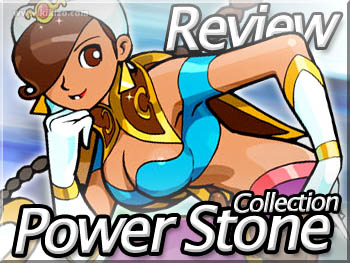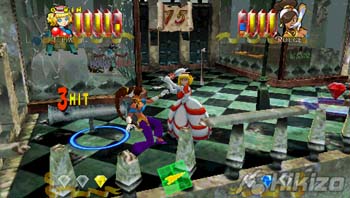Power Stone Collection
We take a detailed look at Capcom's portable revisit to one of Dreamcast's most celebrated fighting series.
| Version PSP | Developer Capcom | Publisher Capcom | Genre Action |
||||
Whether by accident or design, the PSP is fast becoming the handheld home for some great ports, remakes and rehashes of classic retro titles. Whilst this is perhaps a source of consternation for those at Sony HQ, it does allow us gamers to sample the delights of a previous generation that some may not have had the pleasure of experiencing the first time around.

Delights such as WipEout, Street Fighter, OutRun, Ridge Racer and Ghosts'N Goblins to name but a few have all helped shaped the current gaming landscape and have now found a new home on the PSP. But whereas these titles have taken the original franchise and enhanced it with new features, levels, gameplay and graphics, Power Stone Collection stays devoutly true to its source.
In fact, if it wasn't for a couple of minor changes one could be forgiven for thinking that your PSP was simply running a Dreamcast emulator with the original code intact. No bad thing in itself, given some of the fantastic and often criminally overlooked titles that the platform had to offer - but what does Power Stone have to give today's generation of gamers?
"Those looking for something other than a run-of-the-mill beat-em-up will likely find it here."
|
Chief among these was the combination of 2-player action, multiple weapons and the true 3D nature of the gameplay, which was played out in feature-rich interactive environment. No longer were you confined to battling in a pseudo-3D static arena, transfixed onto a 2D plane against a CPU controlled opponent. No, Power Stone provided go-anywhere, grab-anything battles. Barrels could be thrown, chairs kicked, flame-throwers used and ceilings dangled from.
As well as this high level of interactivity the game also revolved around the eponymous Power Stones. Collecting all three of them morphed you into a turbo-charged version of your character, earning a temporary boost in power and gaining access to special moves. Fighters initial start holding one Power Stone each, with the third appearing on the game floor randomly. All three were required in order to power-up and to obtain your opponent's stone you had to pummel them into submission until they dropped it. Only then, could you collect 'em all.
The success of the original game paved the way for its sequel in 2000, imaginatively named Power Stone 2. Continuing directly from where the original left off, the Power Stone heroes have been captured and imprisoned in a mysterious floating castle and must fight their way out. Despite the wafer-thin plot this was widely regarded as the better game, as whilst the original was pure in nature it was a little rough in places. Naturally, the sequel was more refined and polished.
A total of four players could now enter the fray, the number of Power Stones increased to accommodate the greater number of players, the arenas grew vastly in size often being played across huge multi-screen levels, and new characters were added as well as new gameplay modes. In addition, coins and other items could be collected in adventure mode, and afterwards bought, sold and mixed in the item shop. Overall the longevity and variety in this sequel greatly extended that of the original.
All of which reminiscing brings us back to the present day and to Power Stone Collection on the PSP. Essentially the exact same games in one portable package, complete versions of both are included as well as something simply known as Collections, all selectable from the initial menu screen. The Collections option includes extra features such as the bonus Dreamcast VMU games, theatre mode (although this was included in the original games anyway) and some other extra unlockables.
But what about the game ports, I hear you cry? Well both are technically commendable ports, looking and feeling almost exactly like the originals, even more so considering that the button configuration is an exact match for the Dreamcast's (one analogue stick, one D-pad, four face buttons and two shoulder buttons), which makes one wonder why there are not more straight ports from this console.
As to be expected Power Stone 1 is the weaker of the two and it's questionable whether this title is suited to the small screen. With the camera zooming out to keep both characters on-screen, objects are often reduced to minuscule sizes. Couple this with the hectic and packed arenas and one just as often ends up accidentally kicking a table halfway across the room as they do landing the intended killer blow. Thus, the moment passes and battles become won and lost by chance just as much as skill.
Surprisingly this does not occur as often with the sequel, presumably because the arenas are more open. Also should a character fall behind when required to follow a path from A to B, they will are be transported from off-screen back into the fray.
"Hopefully Collection will pave the way for an online, souped-up, turbo-charged Power Stone 3. Now that would be something worth fighting for.."
|
Although the roster is small, both games provide a good mix of characters. The usual suspects are catered for such with the well-balanced (Falcon), slow but powerful (Gunrock) and fast but weak (Ayame). When playing against the CPU, opponents are surprisingly varied, with some first and foremost trying to grab the Power Stones, whilst others just want to knock you down. Thus a change in strategy from the usual beat-em-up mindset is required, especially considering the interactive levels.
The question remains though, what does Power Stone and this Collection offering have to give today's generation of gamers? Other than noticeably long loading times, this is a perfect conversion of the 3D fighting games but beyond that their value is questionable. If you've played the Dreamcast originals and enjoyed those, then there is no doubt you will enjoy these too. Newcomers on the other hand will find this a mixed bag. They're not the most technically accomplished of 3D fighters on the PSP (the recently released Tekken arguably takes that crown), but those looking for something other than a run-of-the-mill beat-em-up will likely find it here.
What most Power Stone fans will really want though is a genuine sequel in the series. Whereas it took the original Power Stone to pave the way for the much better Power Stone 2, hopefully Collection will provide the catalyst and pave the way for an online, souped-up, turbo-charged Power Stone 3. Now that would be something worth fighting for.
| ||||||||||||
|
| Video Coverage (Latest Videos & Video FAQ) | |||
| PLEASE DO NOT DIRECT LINK TO ANY MEDIA FILE ON KIKIZO | |||
| Description | Dur. | Size | Details |
|
Powerstone: Collection Direct feed trailer (PSP - Capcom) |
01:38 | 15MB | DF, SD, 4:3 640x480p30 1.3Mbps |





















 Satoru Iwata Video Interview - the late Nintendo president spoke with Kikizo in 2004 as 'Nintendo Revolution' loomed.
Satoru Iwata Video Interview - the late Nintendo president spoke with Kikizo in 2004 as 'Nintendo Revolution' loomed. Kaz Hirai Video Interview - the first of Kikizo's interviews with the man who went on to become global head of Sony.
Kaz Hirai Video Interview - the first of Kikizo's interviews with the man who went on to become global head of Sony. Ed Fries Video Interview - one of Xbox's founders discusses an epic journey from Excel to Xbox.
Ed Fries Video Interview - one of Xbox's founders discusses an epic journey from Excel to Xbox. Yu Suzuki, the Kikizo Interview - we spend time with one of gaming's most revered creators.
Yu Suzuki, the Kikizo Interview - we spend time with one of gaming's most revered creators. Tetris - The Making of an Icon: Alexey Pajitnov and Henk Rogers reveal the fascinating story behind Tetris
Tetris - The Making of an Icon: Alexey Pajitnov and Henk Rogers reveal the fascinating story behind Tetris Rare founders, Chris and Tim Stamper - their only interview? Genuinely 'rare' sit down with founders of the legendary studio.
Rare founders, Chris and Tim Stamper - their only interview? Genuinely 'rare' sit down with founders of the legendary studio. The History of First-Person Shooters - a retrospective, from Maze War to Modern Warfare
The History of First-Person Shooters - a retrospective, from Maze War to Modern Warfare